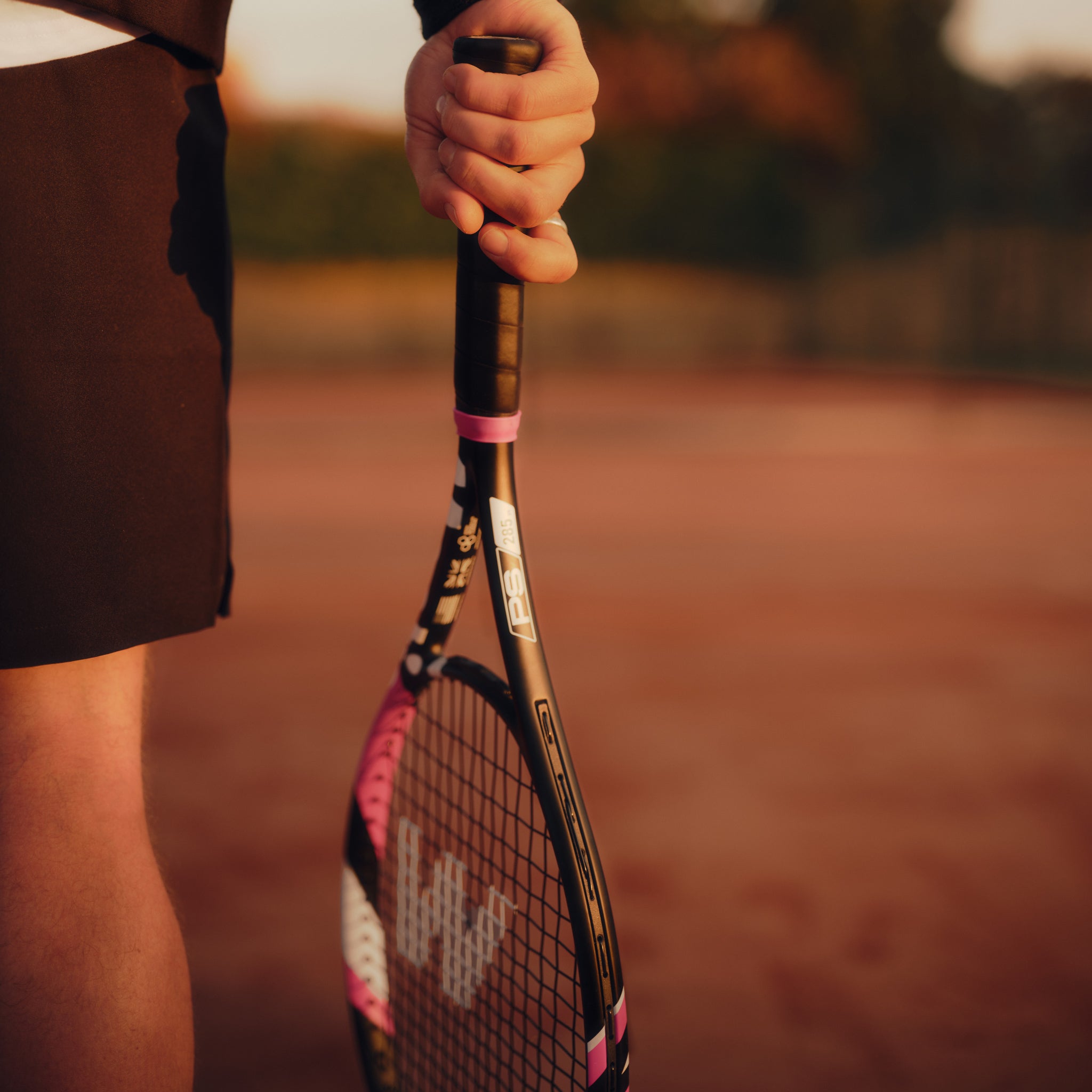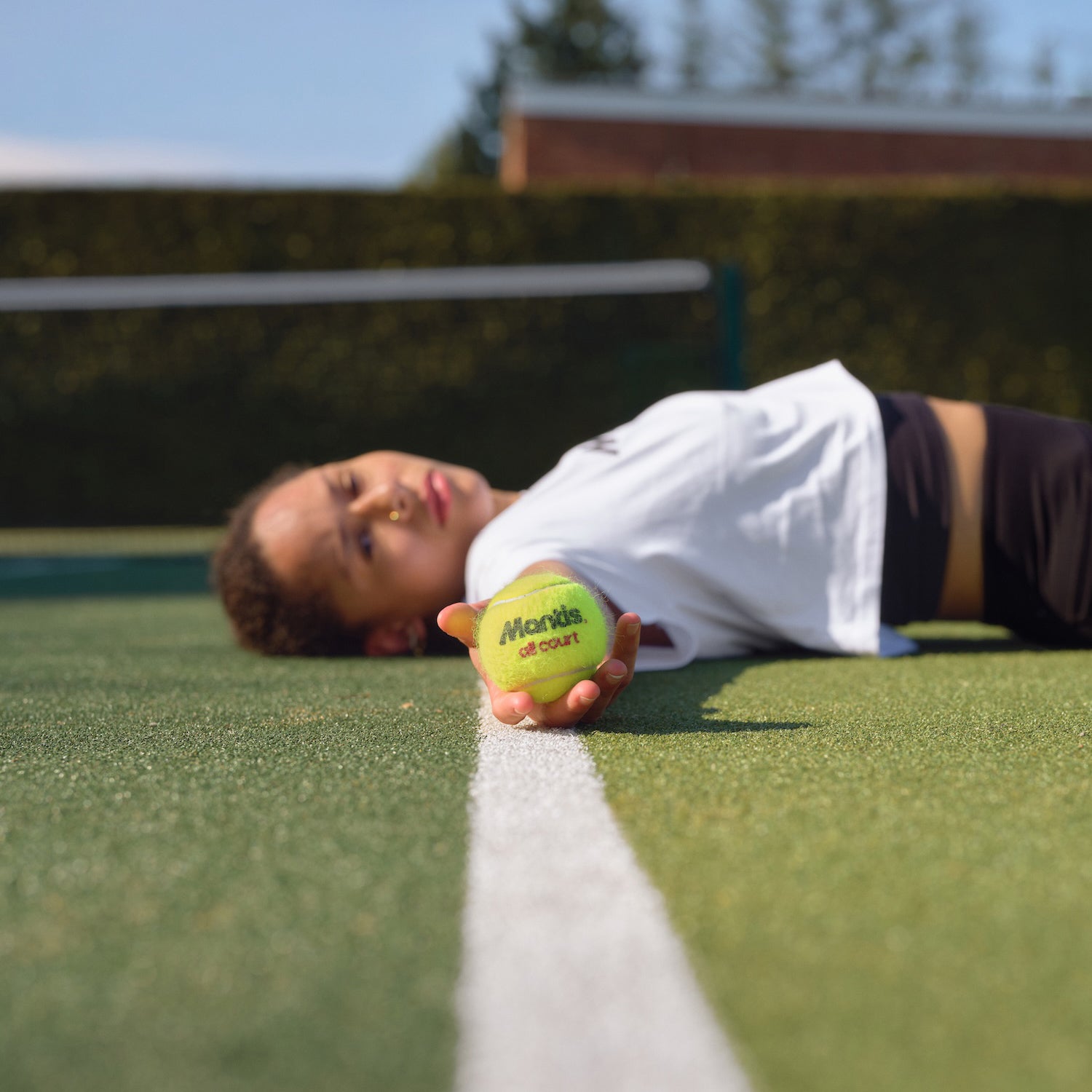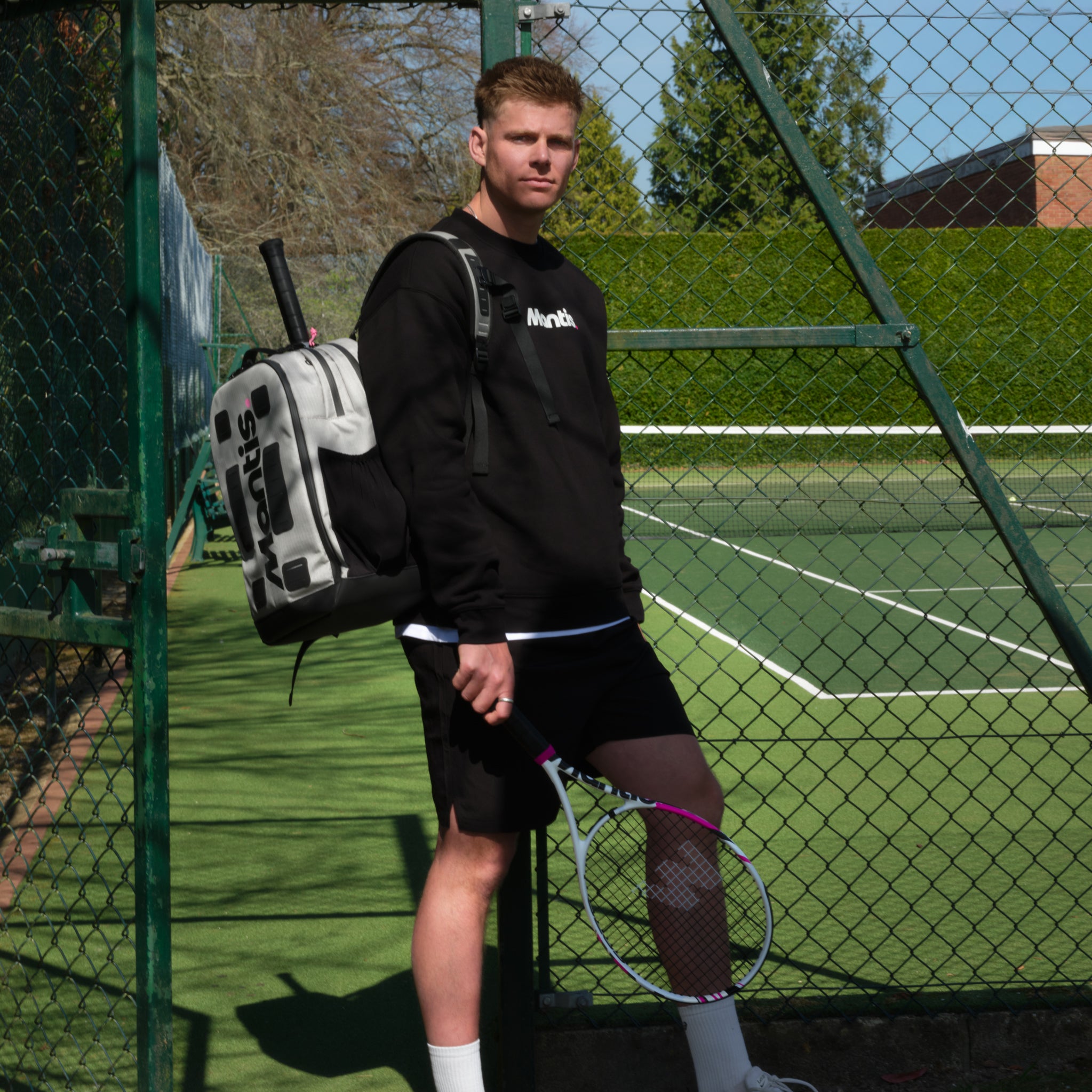
Stepping onto a clay court with the wrong shoes is like trying to drive on ice with summer tyres. You’ll have no control, you’re risking an accident, and your performance is going to be a disaster. The best tennis shoes for clay courts are built for one thing: getting the perfect balance between grip and slide, and it all comes down to their special herringbone tread. That unique pattern is absolutely essential for moving around on a loose, gritty surface safely and with confidence. For more insights on how surfaces impact your game, check out our guide to understanding the different tennis court surfaces.
Why The Right Tennis Shoes for Clay Courts Is Crucial
Wearing all-court or hard-court shoes on clay is one of the most common mistakes we see players make. On the surface, they might look similar, but the way they function is worlds apart, and those differences will show up in every single rally you play. At Mantis, we know that starting with the right gear—especially your shoes—is a massive part of setting yourself up for success.
A clay court just asks different questions of your body and your equipment. The surface is slower, it’s softer underfoot, and it's far less predictable than a hard court. That means you need to move differently, and your shoes have to be up to the job.
The Pitfalls of Using the Wrong Footwear
Using the wrong shoes on clay isn't just a small disadvantage; it creates real problems that hurt your performance and even raise your risk of injury. These aren't just minor annoyances, they can completely change how well you're able to compete.
Here are the key issues you’ll run into:
- You Can't Get a Proper Grip: Hard-court shoes are made with flatter, tougher outsoles designed to resist wear on abrasive concrete. But on clay, those shallow grooves get clogged with the fine red dust in minutes, turning your soles into slippery, unsafe surfaces with almost zero traction.
- You're More Likely to Get Injured: The biggest danger is slipping and falling when you don’t mean to. An unexpected slide can easily lead to a sprained ankle, a pulled muscle, or worse. While clay is generally kinder to your joints because it's soft, you only get that benefit if you can slide with control. If your shoes won't let you, you can overextend and put serious strain on your hamstrings and knees.
- You'll Destroy Your Shoes: The constant sliding on clay’s gritty surface acts like sandpaper on your shoes. The uppers on a standard pair will get shredded in no time. Proper clay court shoes are built tougher, with reinforced material on the inner side and around the toe to handle that friction.
Studies have shown that because clay allows players to slide into shots, it can lead to up to 75% fewer impact-related injuries compared to hard courts. But that huge benefit only kicks in if you can actually control that slide—something that's nearly impossible without the right shoes.
A quick look at the main differences makes it pretty clear why you need a specialised shoe for the dirt.
Clay Court Shoes vs Other Court Shoes at a Glance
This table breaks down the core differences at a glance, showing just how specific the design needs to be for each surface.
| Feature | Clay Court Shoe | Hard Court Shoe | Grass Court Shoe |
|---|---|---|---|
| Outsole Pattern | Full herringbone tread to release clay and provide controlled grip for sliding. | Modified herringbone or varied patterns for durability and grip on a flat surface. | Small rubber nubs or "pimples" for traction on slippery grass without damaging the court. |
| Outsole Material | Softer rubber compound for better grip on loose particles. | Highly durable rubber compound to withstand abrasion from concrete. | Flexible rubber that allows the nubs to grip the turf effectively. |
| Upper Construction | Reinforced medial side and toe for durability against sliding friction. | Often features mesh for breathability, with durable overlays in high-wear areas. | More flexible and lightweight, often with a tighter weave to keep moisture out. |
| Key Performance Trait | Excellent balance of grip and slide, lateral stability. | Durability and cushioning for high-impact movements. | Superior grip on a soft, often damp surface. |
As you can see, each shoe is a piece of specialised equipment, fine-tuned for the unique demands of its environment.
Ultimately, your shoes are not just an accessory; they are a vital piece of performance equipment. Choosing the right tennis shoes for clay ensures you can move with confidence, turning the unique properties of the surface into an advantage instead of something you have to fight against. Your ability to start, stop, and slide with precision begins and ends with what’s on your feet.
The Science of the Perfect Clay Court Outsole
The heart and soul of any truly effective tennis shoes for clay courts lies in the outsole. It’s the only part of the shoe that actually touches the ground, and on a surface as unique as clay, its design is everything. Here at Mantis, we're going to break down what makes a clay court outsole not just different, but essential for your best game. To improve your movement on court, consider integrating specific tennis footwork drills into your training.
Think of a clay court outsole like a specialised winter tyre for your car. Both are engineered to grip a loose, unpredictable surface. The defining feature you'll see on almost every dedicated clay court shoe is the full herringbone tread pattern—that classic zig-zag design built specifically for the fine, dusty top layer of a clay court.
The Genius of the Herringbone Pattern
This isn't just a style choice; the herringbone pattern is a masterpiece of functional design. Its sharp, deep grooves are angled perfectly to do two critical jobs at once. First, they bite into the loose clay, giving you exceptional grip for all those quick, multidirectional movements. This means you can push off for a sprint or change direction with total confidence.
Secondly, and just as importantly, the channels are designed to release clay as you move. The pattern flexes and funnels the fine red dust out from the grooves, stopping it from clogging up. This self-cleaning action is vital, as it prevents the outsole from turning into a flat, slippery mess—a common problem if you wear hard-court shoes on clay.
A non-clogging outsole is the key to consistency. It ensures your traction on the last point of a long set is just as reliable as it was on the first, allowing you to trust your footwork completely.
This intelligent design is exactly what lets players perform those controlled, elegant slides that are so iconic to clay court tennis. It gives you the perfect balance of grip to brake and slide into a shot, and then bite to accelerate explosively towards the next ball.
The infographic below really highlights what a player needs on clay, all of which comes back to a well-designed outsole.
As you can see, it's all about the interplay between grip, the ability to slide safely, and overall stability. That’s what defines success on this surface.
Specialised Rubber for a Softer Surface
Beyond the pattern, the material itself is crucial. The rubber compounds used for clay court outsoles are typically softer than what you'd find on hard-court shoes. A harder rubber, which is great for the wear and tear of concrete, would simply skate over the loose clay without getting any real purchase.
A softer compound, however, moulds and conforms more effectively to the granular surface. This increases the contact area with the ground at any given moment, maximising friction and giving you a much better feel for the court. You feel connected and stable, even when you're scrambling.
The Non-Negotiable Non-Marking Rule
Finally, one universal requirement for clay court shoes is a non-marking outsole. This is a standard rule at pretty much every tennis club to protect the court surface. The specialised rubber compounds are designed to provide fantastic traction without leaving scuffs or streaks on the clay, keeping the courts in good shape for everyone. Always check for a "non-marking" label when buying your shoes.
The huge focus on outsole technology shows just how important it is. The specialised design of tennis shoes for clay courts, particularly that herringbone tread, is critical for delivering the traction and stability you need on such a slippery surface. This specialisation contributes massively to the global market for this footwear, which was valued at $1.18 billion in 2021 alone. It’s clear that players are willing to invest in the right gear, which you can read more about on RacketBusiness.com. This just underscores how much of a difference the right outsole truly makes to your game.
Building a Durable and Breathable Upper
While the outsole gets all the attention for grip, it’s the upper part of the shoe that cradles your foot through every sprint, stop, and slide. On clay, this part of the shoe has a tough job. It needs to be a suit of armour against constant friction, yet feel light and airy enough to get you through a long three-setter in the sun. Here at Mantis, we know that crafting the perfect upper for tennis shoes for clay courts is all about striking that perfect balance. Understanding the various different tennis court surfaces helps put the specific needs of a clay court shoe into perspective.
Think about it: clay-court tennis is all about the slide. Unlike the predictable stop-and-go of a hard court, players are constantly dragging and skidding, putting huge stress on the shoe's upper. If you tried this in a standard running shoe, the abrasive clay would tear through the material in a few matches. That’s why clay-court uppers are specifically engineered for resilience.
The Battle Between Toughness and Comfort
To build an upper that can withstand this abuse, manufacturers typically turn to a combination of synthetic leathers and reinforced mesh. The synthetic materials provide a strong, stable structure that resists stretching, keeping your foot locked in place during those aggressive lateral lunges.
But a shoe made entirely of thick synthetic material would feel like a boot and trap heat—a disaster when you’re playing on clay, often in warm weather. This is where clever material science comes in. Designers strategically place durable synthetic overlays in the high-wear zones while using advanced, tightly woven mesh panels everywhere else. The result is a shoe that’s both tough and breathable.
A modern clay-court upper should offer fortress-like protection where you need it, without turning the shoe into an oven. It’s all about putting the right materials in the right spots.
This targeted design keeps your feet cool and dry, which is crucial for preventing blisters and discomfort when you’re deep into a deciding set.
Essential Reinforcements for Clay-Court Warriors
Sliding isn’t just a random movement; it puts predictable stress on specific parts of the shoe. The best tennis shoes for clay courts anticipate this, featuring reinforcements exactly where they’re needed most.
Key areas of reinforcement include:
- The Medial Side: The inner side of your shoe takes a real beating every time you slide into a shot. This area is nearly always beefed up with a durable material, often called a drag guard, to stop the abrasive clay from shredding the upper.
- The Toe Cap: If you’re an aggressive player who drags their toe on serves or when stretching for a low ball, extra protection up front is non-negotiable. A robust, reinforced toe cap shields the shoe from wear and your toes from impact.
These aren't just cosmetic extras; they are fundamental to the shoe's design and are absolutely critical for its lifespan on a clay court. A shoe without them simply won’t survive.
Lightweight Support for Unrestricted Movement
After all this talk of armour and reinforcement, you might be picturing something heavy and clunky. But no player wants to feel like they’re wearing bricks. Modern manufacturing techniques bond these durable layers together seamlessly, getting rid of bulky stitches and creating a sleek, supportive fit.
The end product is a shoe that feels like a natural extension of your foot. It gives you the stability to trust your movements, the durability to handle the toughest surface, and the breathability to stay comfortable from the first serve to the final point. This careful construction ensures your shoes are an ally, not a hindrance, in your quest for victory on the clay.
How to Find the Perfect Fit and Support
Even the best outsole and the toughest upper are pointless if the shoe doesn’t fit properly. At Mantis, we see a good fit as more than just comfort—it’s your first and most important line of defence against injury. Getting it right means your tennis shoes for clay courts become an extension of your foot, giving you the stability you need for those dynamic slides and quick recoveries. It’s a crucial piece of the puzzle, right up there with mastering your movement, as we break down in our guide to tennis footwork drills.
A poorly fitting shoe isn't just an annoyance; it's a performance killer. Too much wiggle room inside leads to blisters and a lack of confidence in your footwork. Too tight, and you're looking at bruised toes and restricted blood flow.
The Three Pillars of a Perfect Fit
When you’re trying on a new pair, think of it as a checklist for locking your foot in place. Focus on these three critical areas to make sure you get a secure, supportive fit that feels right.
-
A Snug Heel Lock: Your heel should feel securely cupped with almost no slippage when you walk or mimic tennis movements. A slipping heel is a fast track to blisters and makes you feel unstable during quick changes of direction.
-
A Secure Midfoot Wrap: The shoe needs to feel snug across the top of your foot, from the arch to the ball. This stops your foot from sliding side-to-side during lateral lunges, which is absolutely vital for keeping your balance on clay.
-
Sufficient Toe Box Room: You should have about a thumb's width of space (roughly half an inch) between your longest toe and the end of the shoe. This gives your toes room to spread out naturally and stops them from jamming into the front during sudden stops—a classic cause of bruised toenails.
Pro Tip: Always try on shoes later in the day. Your feet naturally swell over the course of the day, especially after you've been active. Shopping in the afternoon or evening gives you a much truer sense of how the shoe will feel during a long, tough match.
Understanding the Midsole's Role in Stability
Beneath your foot lies the midsole, the unsung hero of support and cushioning. On a clay court, rallies are longer and the movements more grinding. The midsole’s job is to absorb all that impact and give you a stable platform for every single step.
Here’s what to look for:
-
EVA Foam: Most high-performance tennis shoes use some form of EVA (ethylene vinyl acetate) foam. It's a lightweight material that’s brilliant at absorbing shock, taking the stress off your joints during explosive movements.
-
TPU Shank: This is a rigid piece of plastic, usually found under the arch. The TPU (thermoplastic polyurethane) shank acts like a little bridge, stopping the shoe from twisting when you make aggressive side-to-side cuts. This torsional stability is essential for preventing ankle rolls and other injuries.
A well-made midsole strikes the perfect balance between soft cushioning for comfort and firm rigidity for support. It ensures your foot stays stable and protected, letting you move with power and confidence.
Ultimately, finding the right fit is a deeply personal process. Different brands and models will feel completely different, so it's essential to try on several pairs and just trust what feels best on your foot. By prioritising a secure heel, a wrapped midfoot, and enough toe room, you can make sure your shoes are a true asset to your game on the clay.
Keeping Your Clay Court Shoes in Top Form
Buying a great pair of tennis shoes for clay courts is the first move, but looking after them is what really counts. A little bit of care goes a very long way, protecting your investment and making sure your shoes perform when you need them to. Here at Mantis, we think that understanding your gear means knowing how to maintain it. For more insights on equipment, be sure to check out our article on the different tennis court surfaces.
The biggest enemy of a clay court shoe is, unsurprisingly, the clay itself. That fine red dust gets everywhere, working its way into the deep herringbone grooves on the bottom and even into the fibres of the upper. If you just leave it there, it will ruin your grip and start breaking down the shoe’s materials far too quickly.
The Art of Cleaning Without Causing Damage
The golden rule for cleaning your shoes is simple: be gentle but be thorough. Blasting them with harsh chemicals or scrubbing too hard can weaken the materials and glues holding everything together, which will seriously shorten their lifespan. Your goal is just to get the clay off, not to strip the shoe back to its bare bones.
A straightforward cleaning routine after every match makes a massive difference.
- Knock Off the Loose Stuff: The second you step off the court, bang your shoes together, sole on sole. This gets rid of the worst of the clay before it dries and hardens.
- Brush Out the Soles: Grab a stiff-bristled brush (an old toothbrush is perfect for this) and scrub the dried clay out of those herringbone grooves. Getting the depth back in those channels is vital for keeping your traction.
- Wipe Down the Uppers: All you need for the top part of the shoe is a soft cloth with a bit of mild soap and water. Gently wipe away the dust, paying a little extra attention to the reinforced areas on the inside of your foot and around the toe.
One of the worst things you can do is throw your clay-caked shoes in the washing machine. It’s a recipe for disaster. The heat and tumbling can warp the shoe’s shape, flatten the cushioning, and completely destroy the glues, causing the shoe to literally fall apart at the seams.
How to Dry Them Properly
Drying your shoes the right way is just as important as cleaning them. It’s tempting to stick them next to a radiator or out in the sun to speed things up, but that’s a guaranteed way to ruin them. Direct heat makes the synthetic materials brittle and causes the glue to fail.
Instead, try this much safer approach:
- Take out the insoles and laces. Let them air-dry on their own. This helps the inside of the shoe breathe.
- Stuff the shoes with crumpled-up newspaper. This is a classic trick for a reason—it soaks up moisture from the inside and helps the shoe keep its shape.
- Leave them in a cool, dry place with good air circulation, well away from any direct heat. You’ll need a bit of patience here; it can take 12-24 hours for them to dry out completely.
Knowing When It’s Time for a New Pair
Even with the best care in the world, no shoe lasts forever. The relentless sliding and stopping on a clay court will eventually wear down even the toughest pair. Playing in worn-out shoes doesn’t just hurt your game; it seriously increases your risk of injury as the support and grip disappear.
Keep an eye out for these tell-tale signs that it's time to retire them:
- A Smooth Outsole: If the sharp zig-zag of the herringbone pattern has worn down and feels smooth to the touch, your grip on the court is practically gone.
- A Compressed Midsole: Look for deep creases and wrinkles along the side of the foam midsole. This means the cushioning has packed down and isn’t absorbing shock anymore.
- Obvious Damage to the Upper: Any tears or holes, especially around the toe-drag area or the inside of the foot, means the shoe has lost its structure and can no longer support you properly.
By sticking to a simple maintenance routine and knowing when to say goodbye, you can make sure your shoes give you the performance and safety you need to play your best on the dirt.
Making an Informed Choice for Your Game
Choosing the right tennis shoes for clay courts isn’t just a purchase; it's a strategic decision that directly impacts how you move, how confident you feel, and how safe you are on the court. Here at Mantis, we want you to see your footwear as a key ally in your game. Understanding what makes a great clay-court shoe turns a simple shopping trip into a way to gain a real performance advantage, similar to how mastering tennis footwork drills enhances your mobility.
Think of it as a balancing act. The entire design of a clay shoe is geared towards mastering this unique surface. Your main focus should be on the features that truly matter here: a full herringbone outsole for that perfect blend of grip and slide, a durable upper to handle all that friction, and a secure fit that delivers unwavering stability and comfort.
Once you have this knowledge, you're in a much stronger position to look at different models and brands with a critical eye. If you're exploring different types of court footwear, checking out a comprehensive review of the latest models can offer some great insights into similar design technologies.
The right shoe doesn't just support your game; it unlocks your potential on clay. It allows you to trust your footwork, move without hesitation, and play with the aggressive yet controlled style the surface demands.
Ultimately, finding the shoe that perfectly complements your playing style and foot type is about giving yourself the best possible tool to succeed. It's an investment in your performance and your enjoyment of the game, making sure every slide, sprint, and stop is executed with total precision.
Frequently Asked Questions
Stepping into the world of specialised tennis gear can feel a bit overwhelming, and it’s natural to have questions. At Mantis, we want you to feel totally confident when you’re picking out your next pair of clay-court shoes. So, we’ve put together answers to some of the most common queries we hear from players just like you.
And remember, while the right shoes are a game-changer, they're part of a bigger picture. Keeping your racket in top shape is just as crucial. Can I Use Hard Court Shoes on Clay?
You can get away with it for a friendly knockabout, but for any kind of serious play, we’d strongly advise against it. The outsoles on hard court shoes are just too smooth and don’t have that deep herringbone grip you need to bite into the clay. This makes slipping a real and constant risk.
Worse still, they’ll clog up with clay almost instantly. You'll lose what little traction you had, turning an already slippery surface into a genuine hazard.
Using hard court shoes on clay is like trying to run on a sandy beach in dress shoes. You'll spend more energy fighting for your footing than playing your game, and the risk of a misstep is dangerously high.
How Long Will My Clay Court Shoes Last?
That really comes down to how you play. The lifespan of your shoes depends on your playing frequency, intensity, and how you move around the court. A competitive player who’s training and playing several times a week might burn through a pair in 2-3 months.
On the other hand, if you play more recreationally, you could easily get a full season or more from your shoes. The key is to keep an eye out for signs of wear. Once that herringbone pattern on the outsole starts to look smooth, or the midsole cushioning feels flat and dead, it’s your cue to get a new pair.
Are All Clay Court Outsoles the Same?
While a full herringbone pattern is the gold standard for tennis shoes for clay courts, you'll find subtle but important differences from one model to the next. Some shoes have a tighter, denser pattern built for maximum grip, perfect for aggressive movers who slide into every shot.
Others might feature slightly wider and deeper grooves, which are designed to release clay more effectively and stop them from clogging up during long, damp matches. The rubber compound can also vary—softer rubber offers incredible grip but wears out faster, while a harder compound will give you better durability. These little tweaks let you find a shoe that’s a perfect match for your game.
At Mantis, we believe that having the right equipment is fundamental to your performance and, most importantly, your enjoyment of the game. Explore our range of high-performance tennis gear, crafted with precision for players who are serious about their progress. Visit us at https://mantissport.com to find the perfect tools for your game.










